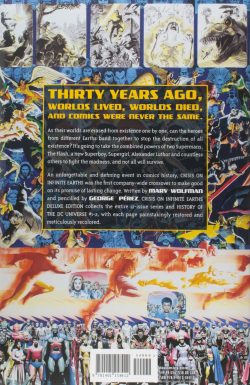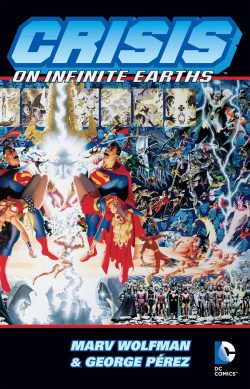

By Marv Wolfman & George Pérez, with Jerry Ordway, Dick Giordano, Mike DeCarlo & various (DC Comics)Â
ISBN: 978-1-4012-5841-2 (HB/Digital edition) 978-1-56389-750-4 (TPB)Â
Once more I’m compelled to dash out another swiftly modified reprinted review to mark the passing of one of our industry and art form’s most prolific and irreplaceable master creators. George Pérez died on May 6th from the complications of pancreatic cancer. He was 67 years old. Â
His triumphs as penciller, writer and an always in-demand inker made him a force to be reckoned with and earned a vast number of awards in a career spanning almost fifty years. Pérez worked for dozens of publishers large and small; self-published his own creations, redeemed and restored many moribund characters and features (like the (New) Teen Titans), Nightwing and Wonder Woman) and co-created many breakthrough characters such as The White Tiger (first Puerto Rican superhero), The Maestro, Deathstroke the Terminator, Terra, The Monitor and Anti-Monitor. Â
He will be most warmly remembered for his incredible facility in portraying big teams and cataclysmic events. Pérez probably drew every DC and Marvel superhero of his era, with major runs on The Avengers, The Fantastic Four, The Justice League of America, Legion of Super-Heroes and numerous iterations of Teen Titans as well as stints on The Inhumans, X-Men, JSA, All-Star Squadron, Thunderbolts and T.H.U.N.D.E.R. Agents. He will be immortalised for the comic book series covered below. A fuller appreciation will follow as soon as I can sort it…Â
In 1985 the Editorial Powers-That-Be at DC Comics were about to celebrate fifty years of publishing, and enjoying a creative upswing that had been a long time coming. A crucial part of the festivities, and purported attempt to simplify five decades of often conflicting stories, was a truly epic year-long saga that would impact every single DC title and reconstruct the entire landscape and history of the DC Universe, with an appearance – however brief – by every character the company had ever published. Easy-peasy, Huh?Â
Additionally, this new start would seek to end an apparent confusion of multiple Earths with similarly named and themed heroes. This – it had been decided – was deterring (sic) new readers. Happily, since then (primarily thanks to movie rom-coms like Sliding Doors) we’ve all become well aware of string theory and parallel universes and can revel in the most basic TV show or kids cartoon proffering the concept of multiples incidences of me and you…Â
Way back then, the result of those good intentions was a groundbreaking 12-part miniseries that spearheaded a vast crossover event: eventually culminating in a hefty graphic novel collection (plus latterly three companion volumes reprinting all the crossovers).Â
The experiment was a huge success, both critically and commercially, and enabled the company to reinvigorate many of their most cherished properties: many of which had been in dire need or some regeneration and renewal. Many fans would argue that DC have been trying to change it back ever since…Â
Plotted long in advance of launch, threads and portents appeared for months in DC’s regular titles, mostly regarding a mysterious arms-and-information broker known as The Monitor. With his beautiful assistant Lyla Michaels/Harbinger he had been gauging each and every being on Earths beyond counting with a view to saving all of Reality. At this juncture, that consisted of uncountable variations of universes existing “side-by-sideâ€, each exhibiting differences varying from minor to monumental. Â
Building on long-established continuity collaborators Marv Wolfman and George Pérez – aided and abetted by Dick Giordano, Mike DeCarlo and Jerry Ordway – began by tweaking things fans knew before taking them on a journey nobody anticipated… It transpired that at the very beginning of time an influence from the future caused Reality to fracture. Rogue Guardian of the Universe Krona obsessively sought to unravel the secret of creation and his probing cause a perfect singular universe to shatter into innumerable self-perpetuating cracked reflections of itself…Â
Now, a wave of antimatter scythes through the Cosmic All, eradicating these separate universes. Before each Armageddon, a tormented immortal named Pariah materialises on an inhabited but doomed world of each Existence. As the story opens, he arrives on an Earth, as its closest dimensional neighbours are experiencing monumental geo-physical disruptions. It’s the end of the World, but The Monitor has a plan. It involves death on a mammoth scale, sacrifice beyond measure, a gathering of the best and worst beings of the surviving Earths and the remaking of time itself to deflect cosmic catastrophe and defeat the being that caused it…Â
Action is tinged with tragedy as many major heroic figures – from the nondescript and forgotten to high, mighty and grand – perish valiantly, falling in apparently futile struggle to preserve some measure of life from the doomed multiverse.Â
Full of plot twists and intrigue, this cosmic comicbook spectacle set the benchmark for all future crossover events, not just DC’s, and is still a qualitative high point seldom reached and never yet surpassed. As well as being a superb blockbuster in its own right and accessible to even the greenest neophyte reader, it is the foundation of all DC’s in-continuity stories since 1985, the basis of a TV phenomenon and absolutely vital reading. Â
More than any other work in a truly stellar career, Crisis on Infinite Earths is the magnum opus George Pérez will be remembered for: It might not be fair, but it’s inescapably true…Â
© 1985, 1986, 2001, 2008, 2015 DC Comics. All Rights Reserved.Â
